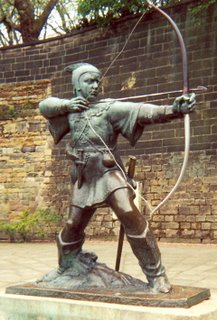 Robin Hood statue, Nottingham, England
Robin Hood statue, Nottingham, EnglandRobin Hood. He is understated in his town, Nottingham, and in his woods, Sherwood Forest. See http://www.localhistories.org/nottingham; and http://www.robinhood.ltd.uk/robinhood/legend. There is a fine interactive museum, however, with tableaux and details and old ledgers.
- Update to 2016: New archeological finds at nearby King's Clipstone, a village where The King's Houises, a/k/a King John's palace documented in 1164 are laid out at Archeology Magazine, Sept-Oct 2016, see http://www.archaeology.org/issues
Robin Hood, according to the exhibits, is a generic type of name, like John Doe, used for any unknown petty criminal or other hapless individual arrested for whatever.
Robin Hood did this, Robin Hood did that. See the ledgers through the years. All those activities over that long period of time could not have referred to one person. But as anywhere, stories illustrate larger truths, and may well not be true in themselves. Legend, myth. Robin Hood. See the tales at http://www.robinhood.info/robinhood/candidates.html
Many Robin Hoods: Perhaps the main model for our Robin Hood was one Robin fitz Ooth, Earl of Huntingdon, born 1160, died 1247, Or Sir Robert Foliot, 1110-1165, or Robert Hod, or Robert de Kyme, 1210-1285, Robert Hood of the Wakefield Roles, 1290-1346, or several others not listed at the robinhood info site above. Or a collage.
Once a figure is identified, religions or social, the stories collect, and soon have a life of their own.
Sunday offers limited visiting hours. Visiting on a Sunday is good for leisurely strolls and a less crowded museum; but not all exhibit areas are open early. The underground caves and dungeon areas beneath the castle area did not open until much later.
Sing it again, Robin Hood riding through the glen, at https://www.youtube.com/watch?v=2w7ALMIUy74
Update 2010: the new film, Robin Hood, at http://www.imdb.com/title/tt0955308/, is fun and fast-fighting, but nothing at Nottingham seems to support the details.